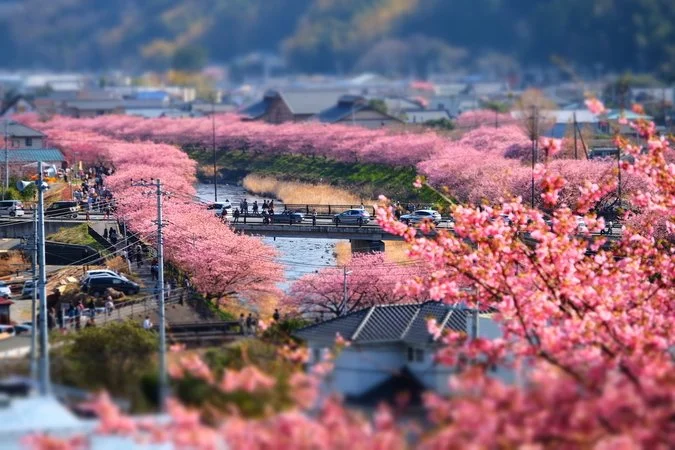Sakura Zensen: Charting the Cherry Blossom Front
Cherry blossoms on full display in Nishinomiya, Japan
The 2025 Sakura Zensen as published by Weather Map Co. Ltd.
The cherry blossom, or sakura, is perhaps the most ubiquitous emblem in Japanese society. From public parks and gardens to seasonal Kit Kats, this five-petaled flower pops up in all sorts of places - even the back of the 100-yen coin. To the people of Japan, the sakura is nature’s yearly reminder to cherish each colorful moment in a life well-lived, no matter how fleeting they may be.
Sakura trees in full bloom during the Kawazu Cherry Blossom Festival in Kawazu, Japan
It’s no surprise, then, that their brief bloom is followed diligently every spring, right alongside the weather forecast. Several private agencies (formerly, the Japan Meteorological Agency) predict the flower’s advance using a combination of daily temperatures, 59 hand-selected trees and one complex mathematical equation. By monitoring the growth of these sample trees and the environmental forces acting on them, meteorologists can reliably determine peak bloom – the point at which 80% of local cherry blossom buds have opened – for each region.
Reports on this “cherry blossom front,” known to Japan as sakura zensen, begin in late March and follow the pink-and-white procession from the southern tip of Kyushu all the way north to Hokkaido prefecture, concluding in mid-May as the last of the flowers unfold. During this time, popular hanami (flower viewing) locations host throngs of people who come to revel in spring’s extravagant return.
Sakura trees lining the river in Kawazu, Japan
According to an analysis by researchers at Kansai University, 63 million people travel each year to and throughout Japan to catch the spectacular sight of blossoming sakura. The window for prime viewing is only about two weeks, so it’s essential that the forecast be accurate, ensuring both tourists and locals have ample time to plan their outings. In addition to hanami gatherings, an assortment of festivals and retail promotions run during this period, which pull an estimated $2.7 billion dollars into the Japanese economy.
It’s recently become a secondary (but crucial) mission of Japan’s meteorologists to assess the impact of a changing climate on the cherry blossom’s natural cycle. In March 2021, Kyoto saw its earliest peak bloom in over a millennium — and subsequent years have largely followed suit. If winter temperatures continue to trend warmer, it’s predicted that the trees will adapt more permanently, their early emergence becoming commonplace by the end of the 21st century.
Despite these changes, the global appeal of sakura grows sweeter each spring. While no country follows the flower quite like Japan, hanami and sakura matsuri (cherry blossom festivals) have attracted significant worldwide attention, with some media outlets even publishing sakura forecasts of their own. This year’s stateside bloom can be tracked on the National Park Service’s Bloom Watch page. Current forecasts point to a peak of March 28-31 in America’s sakura hotspot of Washington. D.C.
Looking to celebrate at home? Explore our favorite sakura-inspired wares - including a preserved blossom of your very own - right here.




